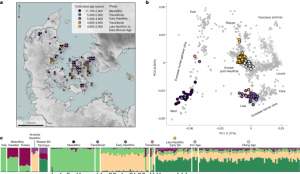
The snowpack is getting smaller in the Northern Hemisphere
The Effects of Climate Change on the Snow-Loss Cliffs and River Basins in ERA5-Land45
The effects of climate change can vary dramatically from place to place, which is why it’s been difficult to suss out the bigger picture with snowpack until recently. Now we can see that many of the hardest hit places also happen to be those that depend on snowpack for their water. Other communities that have seen relatively little impact so far are on track to pass a temperature threshold that would suddenly speed up snow loss, new research published in the journal Nature shows.
The research suggests that most people living in the places where the snow loss is greatest are in the areas that are on the snow-loss cliff.
After a basin has fallen off the cliff, there is no longer a need to deal with a short-term emergency. Instead, they will be adapting to permanent changes to water availability.”
To identify a priori the river basins considered to be snow dominant in Fig. 1, we use the ratio R of water year (October–September) cumulative snowfall to runoff1, calculated from ERA5-Land45. Snowmelt dominant basins have an average R greater than 0.5.
Alex Gottlieb, the author of the new study said that they were able to identify a clearfingerprint of emissions. They were able to see the effect pollution from fossil fuels had on snow trends.
It’s been hard to make this connection until now because global warming leads to both higher temperatures and more precipitation, which can counteract each other. You might have warmer average temperatures, for instance, but heavier snowfall in a storm.
The research reveals a surprising correlation between snow mass and temperature, which has complex ramifications, writes a research professor in an accompanying article.
The study highlights the vulnerability of the region because it is so dependent on both the Colorado River Basin and Sierra Nevada in California.
We calculate the temperature response to anthropogenic forcing as the difference between the 30-year rolling mean average temperature for each month in the HIST and HIST-NAT runs. The forced response is the percentage difference between 30-year rolling mean monthly precipitation in HIST and HIST-Nat. The goal is to limit the influence of models on temperature and precipitation as each model is compared to its own. The model-simulated trends could potentially lead to over- or under-estimation of the forced response. To address this possibility, we evaluate model biases in the 1981–2020 trends in winter temperature and precipitation against observed trends by taking the difference between the CMIP6 HIST ensemble mean and the mean of the observational products for each quantity (Extended Data Fig. 6). To test whether the observed and modelled trends are consistent, we ask whether the observed trend falls within a plausible range of forcing plus internal variability, given as the 2.5–97.5th percentile range of the CMIP6 HIST trends. Only 1% (3%) of grid cells fall outside this range for temperature (precipitation), indicating that the climate models capture realistic historical climate trends.
We also use climate model output from 12 models that archived monthly SWE (‘snw’) The data includes data from the pre-industrial control, historical, HIST, and SSP2CMIP6, as well as monthly air temperature and precipitation. All model output are regridded and masked as with the gridded observational data. The HIST simulations are extended to 2020 using the SSP-2 scenario59, which is consistent with the Detection and Attribution Model Intercomparison Project protocol. For simplicity, ‘historical’ (HIST) will always refer to these extended time series. Model details are given in Extended Data Table 2.
The 1981-2020 River-Basin SWE Dataset with a Reconstruction Model for the Full Panel and Comparison with Observational Data
The estimates of the basin population are based on the 2020 values from the 15 arcsmin gridded population of the world.
We compare the model-predicted time series generated through this process with the observational SWE product on which the model is trained, using the common R2 and RMSE metrics (Extended Data Fig. 4). In addition, we compared the reconstructed trends with the observed trends over the study period and see that our models reproduce the spatial pattern and magnitude of the trends quite well with correlations for all data products falling between 0.9 Furthermore, the RMSE of the construction model predictions is comparable across the 10 coldest, 10 warmest and 20 ‘average’ years in the 1981–2020 period, indicating that the reconstructions are stable even in extreme years (Supplementary Fig. 4).
where SWEy,i is average March SWE in water year ( Ty,m,i is the average temperature for the month of September at grid cell i, and Py,m,i is the total precipitation for the month. We fit the model using the full spatiotemporal panel of 0.5° × 0.5° gridded data (that is, all grid-cell years from 1981 to 2020), then aggregate the predicted gridded values to the river-basin scale. We find that training a single model on the full panel of data offers two main advantages over training multiple models on more local data (for example, a model for each river basin). There is a higher out-of-sample prediction skill in the western US, western Europe and High Mountain Asia and it’s done in a way that’s easier to replicate in local models. Training a single model on data from the entire hemisphere makes it possible to add an end-of-century climate change signal. As records fall, the support of local historical observations will be exceeded.
As an additional test of model skill, we use the model trained on only the gridded observational products to predict fully out-of-sample March SWE at 2,961 in situ sites from the SNOTEL, CanSWE and NH-SWE datasets. In situ SWE has a median R2 across stations of 0.77, and an RMSE of 22%, with our reconstructions. The reconstruction model predictions are similarly able to capture skillfully the long-term SWE trends at the in situ sites, with a pattern correlation of 0.72 (Extended Data Fig. 5). Finally and crucially, we confirm that there are no systematic trends in time of the bias of our reconstructions against the in situ observations (Supplementary Fig. 5), indicating that the reconstruction models are capturing the real-world rate of change of snowpack with high fidelity.
Consistent with previous work in uncertainty partitioning19,41,69, we consider total uncertainty U in the forced SWE trend in basin b to be the sum of all four sources:
Analogous to the basin-scale March SWE attribution described above, the spring runoff change due to forced changes to snowpack is given by the difference between runoff estimated with historical SWE and runoff estimated with the effects of forced temperature and precipitation changes on SWE removed.

